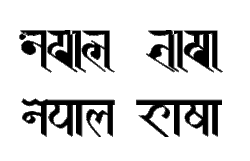Newar language
Sino-Tibetan language of central-eastern Nepal
Nepal Bhasa is a language spoken by indigenous Newa people of Nepal. It is a Himalayan language of Tibeto-Burman branch of the Sino-Tibetan languages group.
| Newa | |
|---|---|
| Nepal Bhasa | |
| नेवाः भाय् Newāh Bhāy | |
 The word "Nepal Bhasa" written in the Ranjana alphabet and the Prachalit Nepal alphabet | |
| Native to | Nepal |
| Ethnicity | 1.26 million Newa people (2001 census?)[1] |
Native speakers | 860,000 (2011 census)[2] |
Sino-Tibetan
| |
Early form | Classical Newa |
| Dialects | |
| Ranjana alphabets and various in the past, Devanagari currently | |
| Official status | |
| Regulated by | Nepal Bhasa Academy |
| Language codes | |
| ISO 639-2 | new Nepal Bhasa, Newari |
| ISO 639-3 | Either:new – Newarnwx – Middle Newa |
Linguist List | newa Nepal Bhasa |
nwx Middle Newa | |
| Glottolog | newa1247 |
Newah Bhaaye is the term used for Nepal Bhasa by its native speakers. The term 'Newari' has been used in derogatory form to replace the original name of the language. [3]
Linguistics
Nepal Bhasa shares the feature of Kirant and Tibetan dialects of Northern Himalayas. It consists of five major dialects and several sub-dialects spoken by Newa people living throughout the country.
References

Newari edition of Wikipedia, the free encyclopedia
🔥 Top keywords: Main PageSpecial:Search0Slash (punctuation)BlackSpecial:RecentChanges4 (number)DavidSOLID (object-oriented design)Wikipedia:AboutFile:Sexual intercourse with internal ejaculation.webmHelp:ContentsHelp:IntroductionLisa Sparxxx2023 UEFA Champions League FinalColour24-hour clockAdolf Hitler UunonaBismillahir Rahmanir Raheem6 (number)T. N. SeshanFile:ASCII-Table-wide.svg20 (number)Poor Things (movie)United StatesCristiano RonaldoList of people who have walked on the MoonAli Malikov50 (number)17 (number)The Valley (2024 TV series)GrassList of mathematical symbolsList of U.S. states and territories by time zone8 (number)List of countries by areaWikipedia:Simple talkList of largest Hindu templesRama
